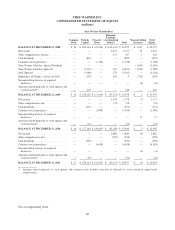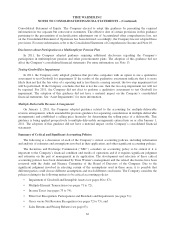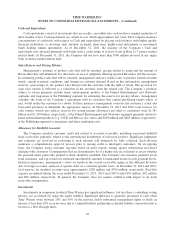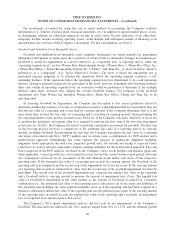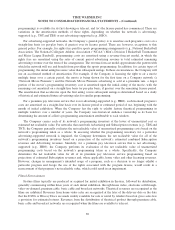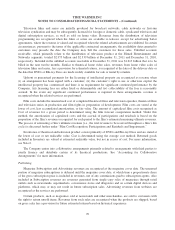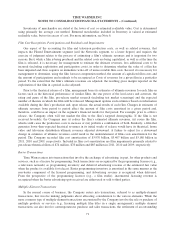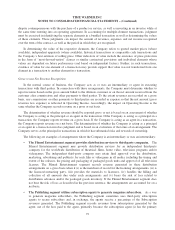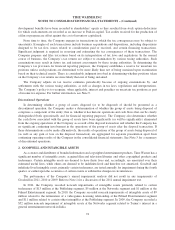Time Magazine 2011 Annual Report Download - page 84
Download and view the complete annual report
Please find page 84 of the 2011 Time Magazine annual report below. You can navigate through the pages in the report by either clicking on the pages listed below, or by using the keyword search tool below to find specific information within the annual report.TIME WARNER INC.
NOTES TO CONSOLIDATED FINANCIAL STATEMENTS – (Continued)
Television films and series are initially produced for broadcast networks, cable networks or first-run
television syndication and may be subsequently licensed for foreign or domestic cable, syndicated television and
digital subscription services, as well as sold on home video. Revenues from the distribution of television
programming are recognized when the films or series are available to telecast, except for advertising barter
agreements, where the revenue is valued and recognized when the related advertisements are exhibited. In certain
circumstances, pursuant to the terms of the applicable contractual arrangements, the availability dates granted to
customers may precede the date the Company may bill the customers for these sales. Unbilled accounts
receivable, which primarily relate to the distribution of television product at the Filmed Entertainment and
Networks segments, totaled $2.975 billion and $2.339 billion at December 31, 2011 and December 31, 2010,
respectively. Included in the unbilled accounts receivable at December 31, 2011 was $1.613 billion that is to be
billed in the next twelve months. Similar to theatrical home video sales, revenues from home video sales of
television films and series, less a provision for estimated returns, is recognized at the later of the delivery date or
the date that DVDs or Blu-ray Discs are made widely available for sale or rental by retailers.
Upfront or guaranteed payments for the licensing of intellectual property are recognized as revenue when
(i) an arrangement has been signed with a customer, (ii) the customer’s right to use or otherwise exploit the
intellectual property has commenced and there is no requirement for significant continued performance by the
Company, (iii) licensing fees are either fixed or determinable and (iv) collectability of the fees is reasonably
assured. In the event any significant continued performance is required in these arrangements, revenue is
recognized when the related services are performed.
Film costs include the unamortized cost of completed theatrical films and television episodes, theatrical films
and television series in production and film rights in preparation of development. Film costs are stated at the
lower of cost, less accumulated amortization, or fair value. The amount of capitalized film costs recognized as
Cost of revenues for a given period is determined using the film forecast computation method. Under this
method, the amortization of capitalized costs and the accrual of participations and residuals is based on the
proportion of the film’s revenues recognized for such period to the film’s estimated remaining ultimate revenues.
The process of estimating a film’s ultimate revenues (i.e., the total revenue to be received throughout a film’s life
cycle) is discussed further under “Film Cost Recognition, Participations and Residuals and Impairments.”
Inventories of theatrical and television product consist primarily of DVDs and Blu-ray Discs and are stated at
the lower of cost or net realizable value. Cost is determined using the average cost method. Returned goods
included in Inventory are valued at estimated realizable value, but not in excess of cost. For more information,
see Note 6.
The Company enters into collaborative arrangements primarily related to arrangements with third parties to
jointly finance and distribute certain of its theatrical productions. See “Accounting for Collaborative
Arrangements” for more information.
Publishing
Magazine Subscription and Advertising revenues are recognized at the magazine cover date. The unearned
portion of magazine subscriptions is deferred until the magazine cover date, at which time a proportionate share
of the gross subscription price is included in revenues, net of any commissions paid to subscription agents. Also
included in Subscription revenues are revenues generated from single-copy sales of magazines through retail
outlets such as newsstands, supermarkets, convenience stores and drugstores and on certain digital devices and
platforms, which may or may not result in future subscription sales. Advertising revenues from websites are
recognized as the services are performed.
Certain products, such as magazines sold at newsstands and other merchandise, are sold to customers with
the right to return unsold items. Revenues from such sales are recognized when the products are shipped, based
on gross sales less a provision for future estimated returns based on historical experience.
70


